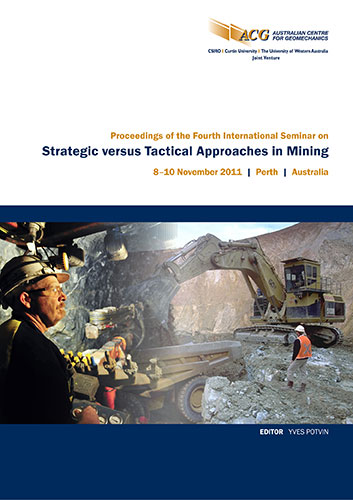Determining waste mining capacities for open pit mines

|
Authors: Jordaan, JT Paper is not available for download Contact Us |
DOI https://doi.org/10.36487/ACG_rep/1108_27_Jordaan
Cite As:
Jordaan, JT 2011, 'Determining waste mining capacities for open pit mines', in Y Potvin (ed.), Strategic versus Tactical 2011: Proceedings of the Fourth International Seminar on Strategic versus Tactical Approaches in Mining, Australian Centre for Geomechanics, Perth, pp. 339-346, https://doi.org/10.36487/ACG_rep/1108_27_Jordaan
Abstract:
It often happens that there is misalignment between the tactical (short-term) and strategic (long-term) mine plans. One scenario where this problem becomes evident is where a dramatic increase in the waste mining rate is required in the long-term that exceeds the practically achievable short-term capability. Before increasing the waste mining rate of a plan, it is important to know the maximum waste mining rate that can be extracted from an open pit mine at any moment in time, as it determines the corresponding operational risk and financial value that resides within the mine plan. Planning within waste mining rate limits is critical to prevent the increase of waste mining rates to unrealistically high levels. Mine plans with high mining rates typically yield higher net present values (NPV) and will be more attractive from a financial perspective. Unrealistically high waste mining rates distorts the cash flow and reflects value that is unlikely to be realised and could result in the wrong decisions being made, inducing both operational and business risk. There are existing empirical guidelines for determining typical waste mining rates for open pit mines, however, these guidelines are based on mining rates that have been historically achieved and do not consider the upper limits of practically executable mining rates which is the focus of this paper. This paper discusses the parameters that limit waste mining rates for open pit mines that practice pushback mining and gives guidance on how to determine realistic waste mining rates that are practically achievable in the short-term which is aligned to the strategic long-term plan.
References:
Long, K.R. (2009) A Test and Re-Estimation of Taylor’s Empirical Capacity-Reserve Relationship, Natural Resources Research,
30 January 2009, International Association for Mathematical Geology, Vol. 18, No. 1, pp. 57–63.
Mathieson, G.A. (1982) Open Pit Sequencing and Scheduling, First International SME-AIME Fall Meeting 1982, Honolulu Hawaii,
4–9 September 1982, SME-AIME, pp. 1–14.
McCarthy, P.L. (2006) Beyond the Feasibility Study – Mine Optimisation in the Real World, in Proceedings 2nd International Seminar on Strategic versus Tactical Approaches in Mining, Y. Potvin (ed), 8–10 March 2006, Perth, Australia, Australian Centre for Geomechanics, Perth, Section 16, 7 p.
Taylor, H.K. (1986) Rates of Working Mines – A Simple Rule of Thumb, Technical Note, Transactions IMM, October, Vol. 95,
pp. A203–204.
© Copyright 2025, Australian Centre for Geomechanics (ACG), The University of Western Australia. All rights reserved.
View copyright/legal information
Please direct any queries or error reports to repository-acg@uwa.edu.au
View copyright/legal information
Please direct any queries or error reports to repository-acg@uwa.edu.au